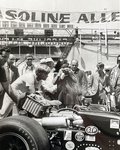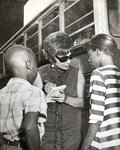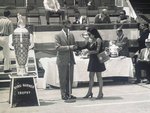



Bettie Cadou knew what she was capable of as a young journalist, but just lacked the career-breaking opportunity.
That was until May 28, 1971 — when the Montgomery County native would go where no female journalist had ever been before.
Gasoline Alley at the Indianapolis Motor Speedway.
With the help of Women’s World magazine’s Mari McCloskey and her lawsuit against IMS, history was made 50 years ago this weekend when Tony Hulman handed Cadou a Silver Badge — granting her equal access to the Indianapolis 500 drivers as her male colleagues.
A ‘Women’s Section’ reporter for the Indianapolis News, Cadou was already ahead of her time as a female journalist.
“At that time, women were unfairly viewed as only wives and mothers, and here’s this mother of three, who had been at the Indianapolis News covering societal pages content, because that’s where she was relegated to,” Cadou’s son, Tad Fruits, said.
Cadou would cover the month of May at IMS by talking with the wives and children of the drivers, but lacked all-access to the drivers themselves until 1971.
“That recognition really provided her with an opportunity to break out of those womens pages at the paper and into her own ambition and aspirations,” Tad added. “At that time she knew what she was capable of, just didn’t have the opportunity to prove it.”
Cadou’s barrier-breaking feat at the track in 1971 was enough to make an accomplished career for the 35-year-old sports journalist, but it only springboarded her to even more important work.
Just a few months after the Indy 500 in 1971, Cadou went undercover at a migrant camp near Frankfort. Her report titled ‘Children of the Fields,’ led to changes in state laws regarding sanitation and working conditions for migrant laborers. She was awared the CASPER Award for her accomplishments.
“That award was an honor to her, but that’s not what she was going for,” her daughter, Kitty O’Doherty, said. “She was wanting to make some change. And opening people’s eyes to things.”
So she kept working, and kept paving the way. There was no story too big or too small for Cadou. Nothing too simple nor too challenging.
She interviewed convicted murder and Indiana Outlaw Motorcycle gang member Steven Weaver in jail, covered Klu Klux Klan rallies, and wrote a story about water pollution from the eyes of the fish.
During the Jim Harbuagh era, Cadou was the editor and writer for the Colts Report, where she joined her son, Tad, who was a photographer, in coverage of the NFL.
“She had a great joy for sports and covering the Colts,” Tad said. “And for her and I to share an experience photographing and writing.
“She was then and always will be a hero to me. And same with my two older sisters, Kitty and Laura, we looked up to her.”
Over the years, Cadou had bylines in Sports Illustrated and the New York Times, and spent time covering the Indiana Gerneral Assembly and had published work of many profiles on national race car drivers.
She extended her passion for storytelling to both IUPUI and Butler as a journalism professor.
Always teaching, and always bringing a laugh and smile to those around her.
“To me she was my second mother, she was just always very sweet, very loving and she was the one that wanted a career and she got it in many ways,” her younger sister, Pat Ogden, said. “She was just a very loving and caring person.”
Ogden said Cadou was preparing to write a book when she passed away in 2002 at the age of 66. In 2006, she was elected into the Indiana Journalism Hall of Fame and has a journalism scholarship in her name in the Department of Journalism at IUPUI.
Cadou never passed up a story opportunity. Always ready with a pen and paper in one hand and a camera in the other. Her career work has helped carve the path for many more female journalists with the same drive and passion she carried.
Bettie Cadou walked so writers like Jenna Fryer, owners like Beth Paretta, and drivers like Simona De Silvestro could run.
There is still progress to be made, but life for women at the Indianapolis Motor Speedway was never the same after May 28, 1971.